- Selecting the Right Strawberry Variety
- Preparing the Soil for Planting
- 1. Choose the Right Location
- 2. Test the Soil
- 3. Remove Weeds and Debris
- 4. Loosen the Soil
- 5. Add Organic Matter
- 6. Apply Fertilizer
- Finding the Ideal Location for Your Strawberry Patch
- Sunlight
- Soil
- Protection from Wind
- Summary
- Providing Proper Sunlight for Your Plants
- 1. Location
- 2. Sun Exposure
- 3. Orientation
- 4. Shade Protection
- 5. Adjustments
- Properly Watering Your Strawberry Plants
- 1. Watering Frequency
- 2. Watering Methods
- 3. Deep Watering
- 4. Watering in the Morning
- 5. Mulching
- 6. Monitoring
- Mulching to Retain Moisture and Control Weeds
- Benefits of Mulching
- Choosing the Right Mulch
- Applying Mulch
- Fertilizing Your Strawberry Plants for Optimal Growth
- 1. Choose the Right Fertilizer
- 2. Apply Fertilizer at the Right Time
- 3. Use the Correct Application Method
- 4. Adjust Fertilizer Rates Based on Plant Growth
- 5. Water After Fertilizing
- 6. Monitor Soil pH
- Pruning and Maintaining Your Strawberry Plants
- 1. Removing Dead or Diseased Leaves
- 2. Maintaining a Tidy Planting Area
- 3. Selective Thinning of Runners
- 4. Regular Fertilization and Watering
- Question-answer:
- What are some proper techniques for planting strawberries?
- Why is it important to remove weeds before planting strawberries?
- How should the soil be prepared for planting strawberries?
- Can strawberries be planted in raised beds or mounds?
- How far apart should strawberry plants be spaced?
- What are the sunlight requirements for strawberry plants?
- How often should strawberry plants be watered?
- Video: Growing Strawberries (Part 2): Pruning, Pests, and Harvesting

When it comes to growing strawberries, proper planting techniques are essential to ensure a bountiful harvest. Whether you are a beginner or an experienced gardener, following the right steps will help your strawberries thrive and produce delicious fruits. This article will guide you through the process of planting strawberries, from site selection to soil preparation and planting methods.
Site Selection: The first step in planting strawberries is to select the right site. Strawberries thrive in full sun, so choose a location that receives at least 6-8 hours of direct sunlight per day. They also prefer well-draining soil to prevent waterlogged roots. Additionally, ensure that the site has good air circulation to reduce the risk of disease.
Soil Preparation: Before planting strawberries, it is important to prepare the soil properly. Start by removing any weeds or grass from the planting area. Then, loosen the soil with a garden fork and remove any rocks or large clumps. Add organic matter, such as compost or well-rotted manure, to improve soil fertility and drainage. Work the organic matter into the soil to a depth of 6-8 inches.
Planting Methods: There are several planting methods you can choose from when it comes to strawberries. One common method is the matted row system, where plants are spaced about 18-24 inches apart in rows, allowing them to send out runners and form a dense mat of plants. Another method is the hill system, where plants are spaced about 12-15 inches apart in raised mounds, with the runners removed to promote larger fruit production.
It is important to note that proper spacing is crucial to allow air circulation and prevent the spread of diseases. Regardless of the planting method you choose, make sure to space the plants correctly and allow enough room for them to grow and spread.
By following these proper planting techniques, you can ensure that your strawberries have the best chance of producing a bountiful harvest. Remember to choose a sunny site, prepare the soil well, and use the appropriate planting method. With a little care and attention, you can enjoy juicy and delicious strawberries straight from your own garden.
Selecting the Right Strawberry Variety
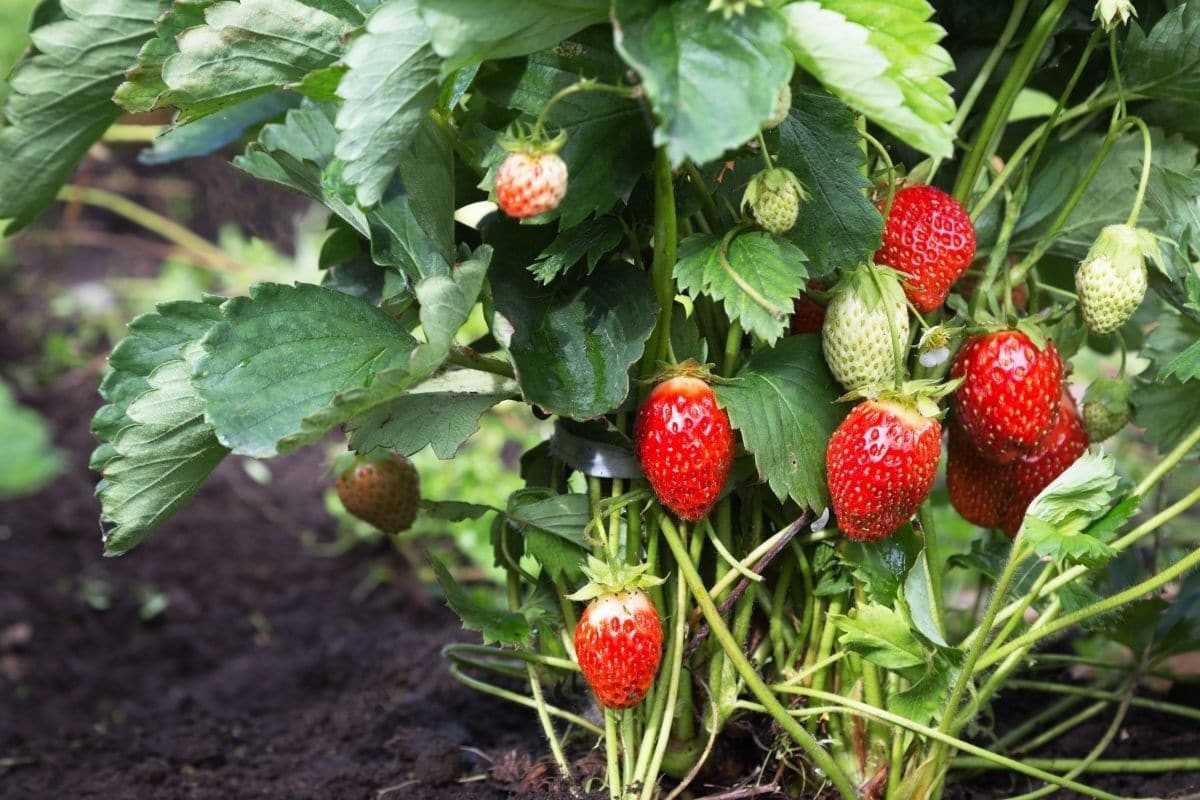

Choosing the right strawberry variety is crucial for a successful harvest. Each variety has its own characteristics, such as taste, size, and disease resistance, which should be considered before making a selection. Here are some factors to consider when selecting a strawberry variety:
- Climate: Different strawberry varieties are better suited for specific climates. Some varieties thrive in cooler climates, while others are more tolerant of heat and humidity. Consider your local climate and choose a variety that is known to perform well in similar conditions.
- Taste: Strawberries come in a variety of flavors, ranging from sweet to tart. Decide whether you prefer a more sweet or tangy flavor, and select a variety that matches your taste preference.
- Size: Strawberry varieties can vary greatly in size. Some produce small berries, while others yield larger fruits. Consider whether you want larger berries for fresh eating or smaller berries for baking and preserving.
- Harvest Time: Different strawberry varieties have different maturation times. Some varieties produce early season berries, while others are late season producers. Consider when you want to harvest strawberries and choose a variety that aligns with your desired harvest time.
- Disease Resistance: Certain strawberry varieties have stronger resistance to common diseases, such as powdery mildew and verticillium wilt. If you live in an area prone to these diseases, select a variety known for its resistance.
It’s also a good idea to consult with local nurseries or gardening experts who can provide recommendations based on your specific growing conditions and preferences. Taking the time to select the right strawberry variety will set you up for a productive and enjoyable strawberry harvest.
Preparing the Soil for Planting
Properly preparing the soil is essential for successful strawberry planting. By creating the right conditions, you can ensure that your strawberry plants have a healthy start and grow vigorously. Here are the key steps to follow when preparing the soil for planting strawberries:
1. Choose the Right Location
Strawberries thrive in well-drained soil with full sun exposure. Select a location in your garden that receives at least 6-8 hours of direct sunlight each day. Avoid areas with heavy clay soil or those prone to standing water, as excess moisture can cause root rot.
2. Test the Soil
Before planting, it’s crucial to test the pH and fertility of your soil. Strawberries prefer slightly acidic soil with a pH between 5.5 and 6.5. You can use a soil testing kit or send a soil sample to a local extension office for analysis. Based on the results, you may need to amend the soil to adjust the pH and nutrient levels.
3. Remove Weeds and Debris
Prior to planting, clear the area of any weeds, rocks, or other debris. Weeds can compete with the strawberry plants for nutrients and water, so it’s important to eliminate them before planting.
4. Loosen the Soil
Using a garden fork or tiller, loosen the soil to a depth of at least 8-10 inches. This will help improve drainage and allow the strawberry roots to penetrate the soil easily. Break up any clumps and remove any large rocks or roots you encounter.
5. Add Organic Matter
Incorporating organic matter into the soil can improve its structure, moisture retention, and fertility. Spread a layer of compost or well-rotted manure over the planting area and mix it into the top 2-4 inches of soil. This will enrich the soil with nutrients and provide a loose, crumbly texture that encourages healthy root growth.
6. Apply Fertilizer
Before planting, apply a balanced fertilizer that is low in nitrogen but high in phosphorus and potassium. This will promote strong root and flower development. Follow the package instructions for the recommended application rate and method.
By following these steps, you can ensure that your soil is prepared and optimized for strawberry planting. This will give your plants the best chance of thriving and producing a bountiful harvest.
Finding the Ideal Location for Your Strawberry Patch
In order to ensure a bountiful harvest of strawberries, it’s important to choose the right location for your strawberry patch. The ideal location will provide the necessary sunlight, well-drained soil, and protection from strong winds.
Sunlight
Strawberries thrive in full sun, so it’s important to choose a location that receives at least 6-8 hours of direct sunlight each day. Ideally, the patch should be situated in a spot that faces south or southwest to maximize sun exposure.
Soil
The soil in your strawberry patch should be well-drained, as strawberries are susceptible to rot and disease in overly wet conditions. Test the soil to ensure it has a pH level between 5.5 and 6.5, which is ideal for strawberries. If the pH is too high, you can lower it by adding sulfur or aluminum sulfate. If the pH is too low, you can raise it by adding lime or wood ashes.
In addition to proper drainage and pH level, the soil should also be rich in organic matter. Adding compost or well-rotted manure to the soil before planting will improve its fertility and moisture retention.
Protection from Wind
Strong winds can damage strawberry plants and cause them to dry out. To protect your strawberry patch from wind, choose a location that is sheltered by a fence, wall, hedge, or existing vegetation. If necessary, you can also create a windbreak by planting wind-resistant shrubs or erecting a temporary barrier.
Summary
When selecting the location for your strawberry patch, consider the amount of sunlight, soil drainage and pH, and protection from wind. Finding the ideal location will provide the best conditions for your strawberry plants to thrive and produce a bountiful harvest.
Providing Proper Sunlight for Your Plants
In order to ensure a bountiful harvest of strawberries, it is important to provide your plants with proper sunlight. Strawberries, like most plants, require a certain amount of sunlight to thrive and produce optimal fruit. Here are some tips for providing the right amount of sunlight for your strawberry plants:
1. Location
Choose a location for planting your strawberries that receives at least 6-8 hours of direct sunlight per day. This will ensure that your plants receive enough light to photosynthesize and produce energy for growth.
2. Sun Exposure
When planting your strawberry plants, make sure they are positioned in a way that allows them to receive direct sunlight for the majority of the day. Avoid planting them in shady areas or in the shadow of tall structures or trees.
3. Orientation
For maximum sun exposure, orient your strawberry plants so that they face south or southeast. This will ensure that they receive the most sunlight possible throughout the day.
4. Shade Protection
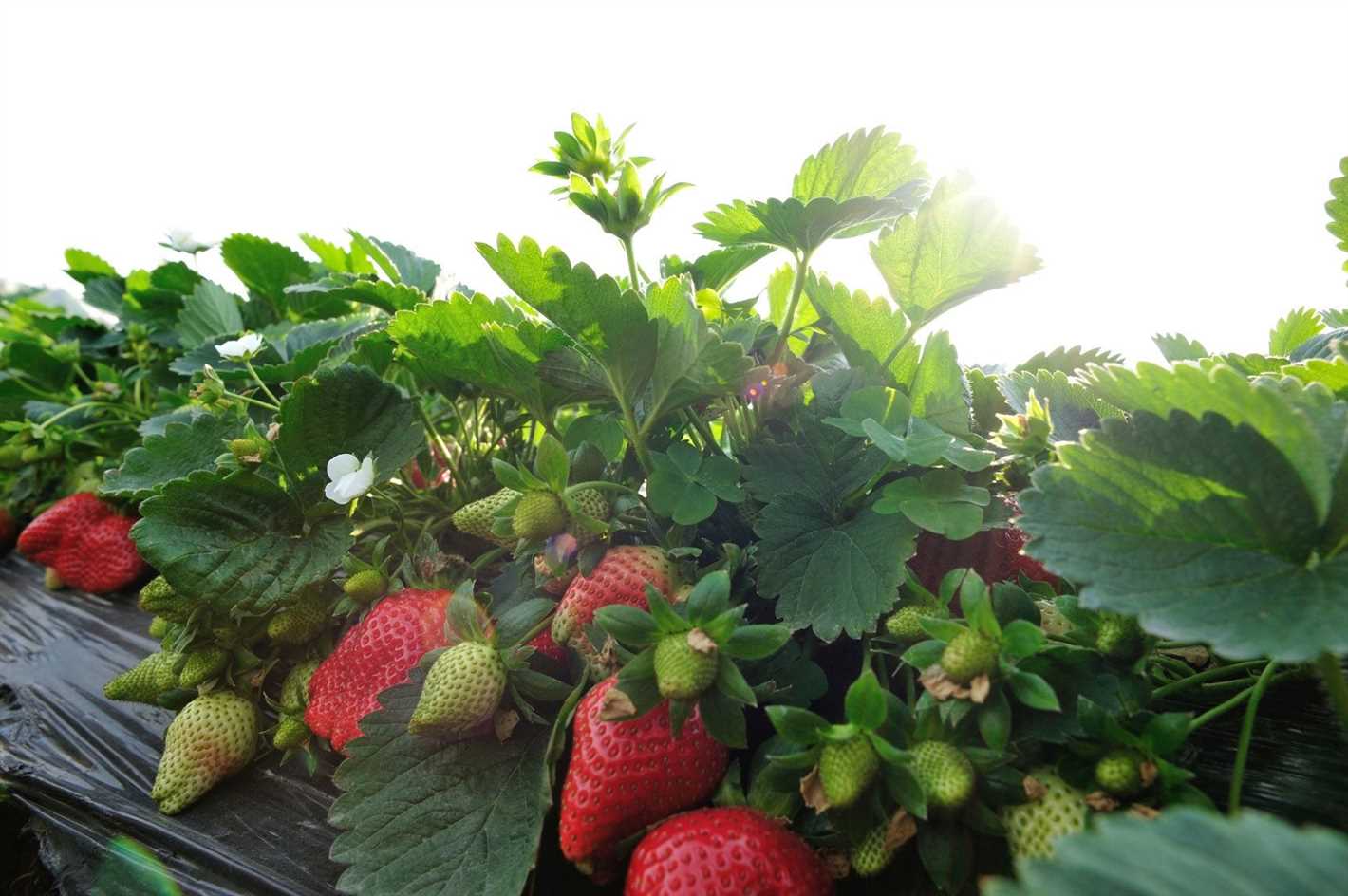

While strawberries require ample sunlight, it is also important to protect them from excessive heat or direct sun exposure during the hottest parts of the day. Consider using shade cloth or providing some form of temporary shade to prevent sunburn and maintain optimal growing conditions.
5. Adjustments
Monitor the sunlight conditions in your strawberry garden and make adjustments as needed. If you notice that certain plants are not receiving enough sunlight, consider transplanting or repositioning them to a sunnier spot.
By providing proper sunlight for your strawberry plants, you can ensure their healthy growth and a bountiful harvest of delicious strawberries. Remember to monitor the sunlight conditions and make adjustments as needed to maintain optimal growing conditions for your plants.
Properly Watering Your Strawberry Plants
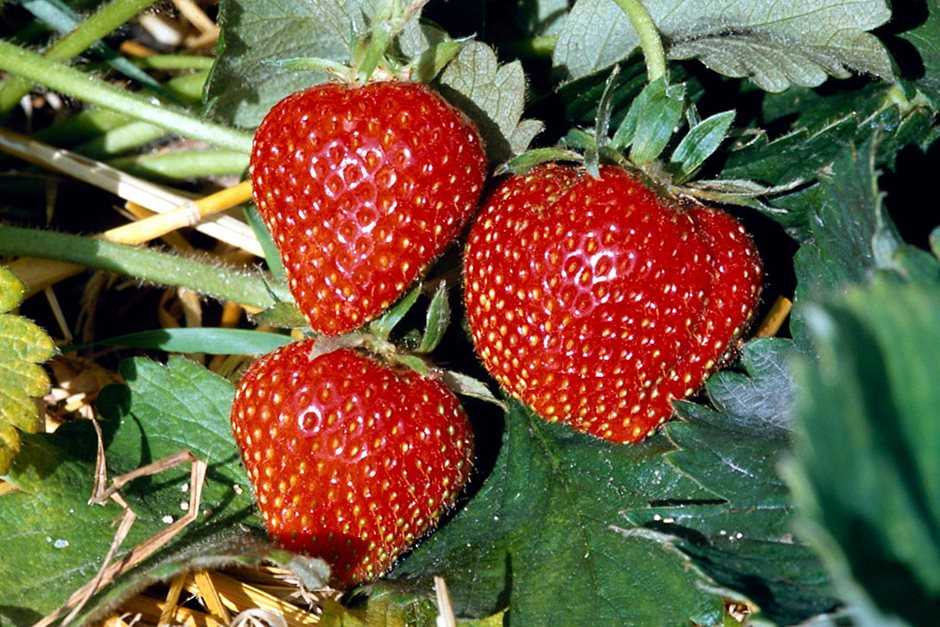

Watering your strawberry plants properly is essential for ensuring a bountiful harvest. The following techniques will help you provide the right amount of moisture to your plants:
1. Watering Frequency
Strawberry plants require consistent moisture, especially during the growing season. They should be watered regularly, typically 1-2 inches per week. However, the frequency may vary depending on your climate and soil conditions. Monitor the moisture level in your soil and adjust your watering schedule accordingly.
2. Watering Methods
To avoid wetting the leaves and promoting diseases, it is best to water strawberry plants at the base. Use a watering can or a drip irrigation system to deliver water directly to the soil. Avoid using sprinklers that can wet the foliage and increase the risk of fungal diseases.
3. Deep Watering
When watering your strawberry plants, aim to wet the soil deeply. Shallow watering leads to shallow root growth, making the plants more susceptible to drought. Water the plants until the soil is moist at least 6-8 inches deep. This will encourage the roots to grow deeper and make the plants more resilient.
4. Watering in the Morning
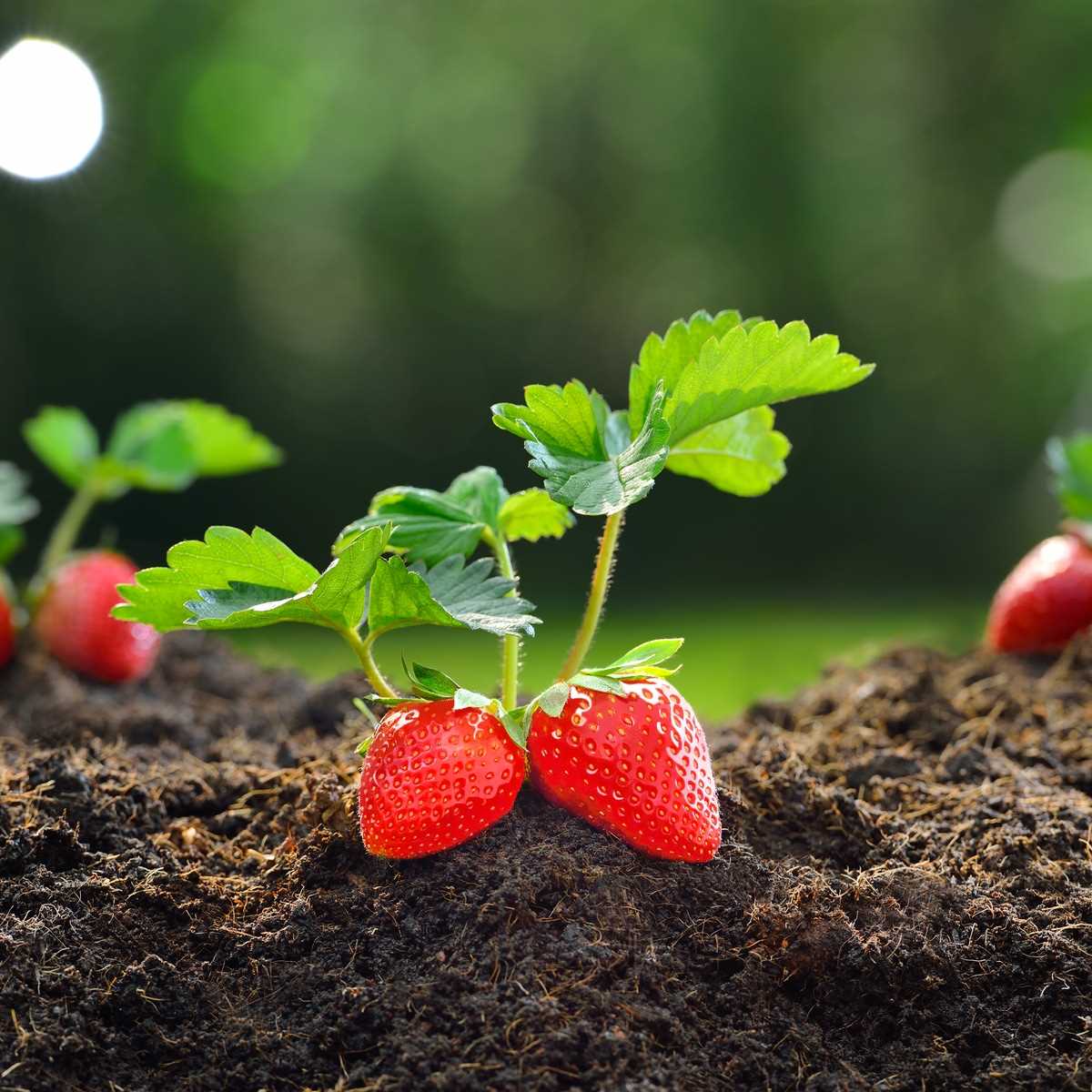

It is best to water your strawberry plants in the morning, preferably before the heat of the day. This allows the plants to absorb the water and dry out before evening, reducing the risk of diseases caused by prolonged leaf wetness.
5. Mulching
Applying a layer of mulch around your strawberry plants can help retain moisture and reduce the frequency of watering. Use organic mulch, such as straw or wood chips, and apply it to a depth of 2-3 inches. Mulch will also help suppress weeds and regulate soil temperature.
6. Monitoring
Regularly monitor the moisture level of your soil to ensure it remains damp but not overly saturated. Stick your finger into the soil up to the second knuckle – if it feels dry at this depth, it’s time to water. Avoid overwatering, as this can lead to root rot and other problems.
By following these watering techniques, you can provide your strawberry plants with the proper amount of moisture and set the stage for a bountiful harvest.
Mulching to Retain Moisture and Control Weeds
Mulching is an essential step in planting strawberries. It helps to retain moisture in the soil and control weed growth, ensuring a healthy and bountiful harvest. There are several types of mulch that can be used, including straw, shredded leaves, and pine needles.
Benefits of Mulching
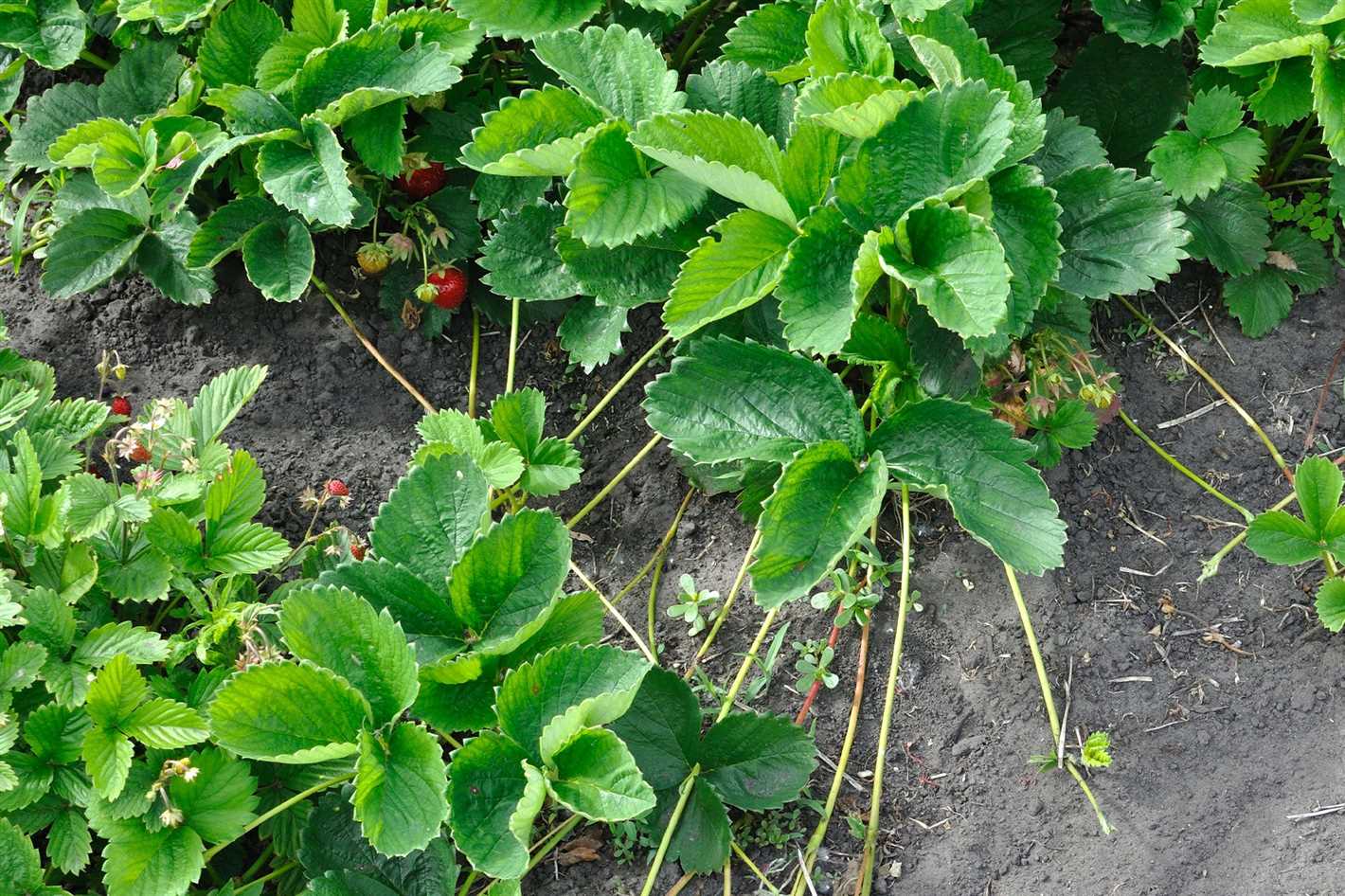

By mulching your strawberry plants, you provide several important benefits:
- Moisture retention: Mulch acts as a barrier, preventing evaporation of water from the soil. This helps to keep the plant roots consistently moist, which is essential for healthy strawberry growth.
- Weed suppression: Mulch helps to smother weeds by blocking out the sunlight they need to grow. This reduces competition for nutrients and space, allowing your strawberry plants to thrive.
- Temperature moderation: Mulch acts as an insulating layer, protecting the strawberry plants from extreme temperatures. It helps to keep the soil cool in hot weather and provides some insulation during cold spells.
- Soil erosion prevention: Mulch helps to prevent soil erosion by providing a protective covering over the soil surface. This is especially important on sloping terrain or in areas with heavy rainfall.
Choosing the Right Mulch
When selecting a mulch for your strawberry plants, consider these factors:
- Material: The most common mulches for strawberries are straw, shredded leaves, and pine needles. All of these materials are effective at retaining moisture and controlling weeds. Choose a mulch that is readily available in your area.
- Depth: Apply the mulch in a layer around 2-3 inches deep. This will provide adequate coverage without smothering the strawberry plants.
- Organic vs. inorganic: Organic mulches, such as straw and shredded leaves, break down over time and add organic matter to the soil. Inorganic mulches, such as plastic or landscape fabric, offer long-term weed control but do not contribute to soil fertility.
Applying Mulch
Follow these steps to properly apply mulch to your strawberry plants:
- Clean the area around the strawberry plants, removing any weeds or debris.
- Water the soil thoroughly to ensure it is moist before applying the mulch.
- Spread the mulch evenly around the plants, making sure to cover the entire root zone.
- Avoid piling the mulch directly against the base of the plants, as this can create a habitat for pests or cause rotting.
- Monitor the mulched area regularly and replenish the mulch as needed. Over time, the mulch will break down and may need to be topped up.
Mulching is a simple but effective technique to improve the health and productivity of your strawberry plants. By retaining moisture in the soil and controlling weeds, mulch helps to create optimal growing conditions for a bountiful harvest.
Fertilizing Your Strawberry Plants for Optimal Growth
Fertilizing your strawberry plants is a crucial step in ensuring their optimal growth and a bountiful harvest. Strawberries require specific nutrients to thrive and produce large, juicy fruits. Here are some tips on how to fertilize your strawberry plants effectively:
1. Choose the Right Fertilizer
When selecting a fertilizer for your strawberry plants, look for a balanced formula that contains nitrogen (N), phosphorus (P), and potassium (K). A fertilizer with an NPK ratio of 10-10-10 or 14-14-14 is ideal for strawberries. Additionally, consider choosing an organic fertilizer to promote long-term soil health and minimize chemical exposure.
2. Apply Fertilizer at the Right Time
Timing is important when it comes to fertilizing strawberry plants. Apply the first round of fertilizer in early spring, just as the plants start to break dormancy. This initial feeding will provide the necessary nutrients for strong plant growth and development. Follow up with additional applications every 4-6 weeks throughout the growing season to ensure consistent nutrient supply.
3. Use the Correct Application Method
When applying fertilizer to strawberry plants, it’s important to avoid direct contact with the leaves or stems. Instead, spread the fertilizer evenly around the base of the plants, keeping it at least 6 inches away from the crowns. This will allow the roots to absorb the nutrients efficiently without causing any damage.
4. Adjust Fertilizer Rates Based on Plant Growth
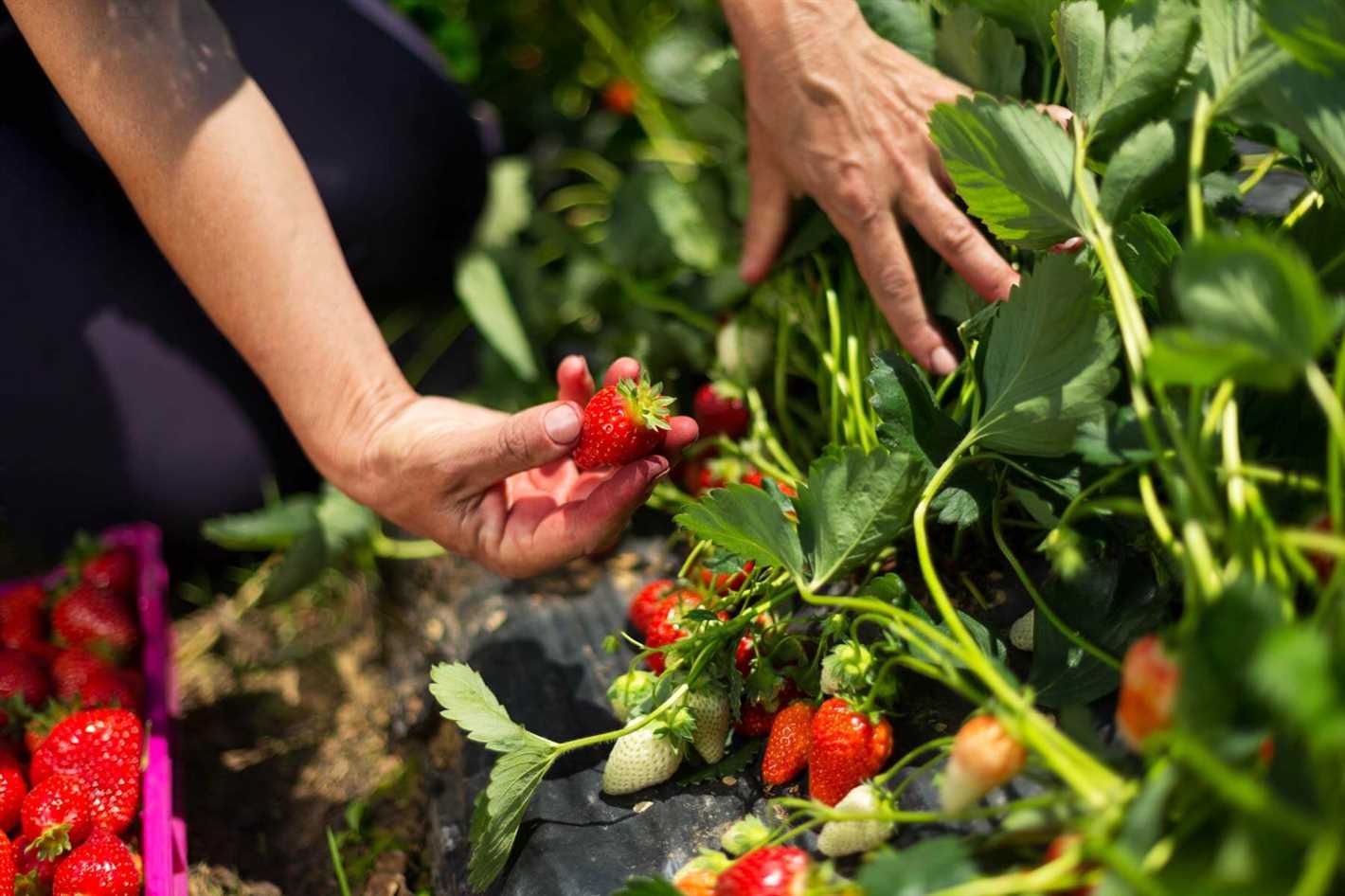

As your strawberry plants grow and mature, their nutrient needs may vary. To ensure optimal growth, monitor the plants closely and adjust the fertilizer rates accordingly. If the plants are showing signs of stunted growth or nutrient deficiencies, consider increasing the fertilizer concentration. On the other hand, if the plants are growing vigorously with dark green leaves, reduce the amount of fertilizer to avoid overfeeding.
5. Water After Fertilizing
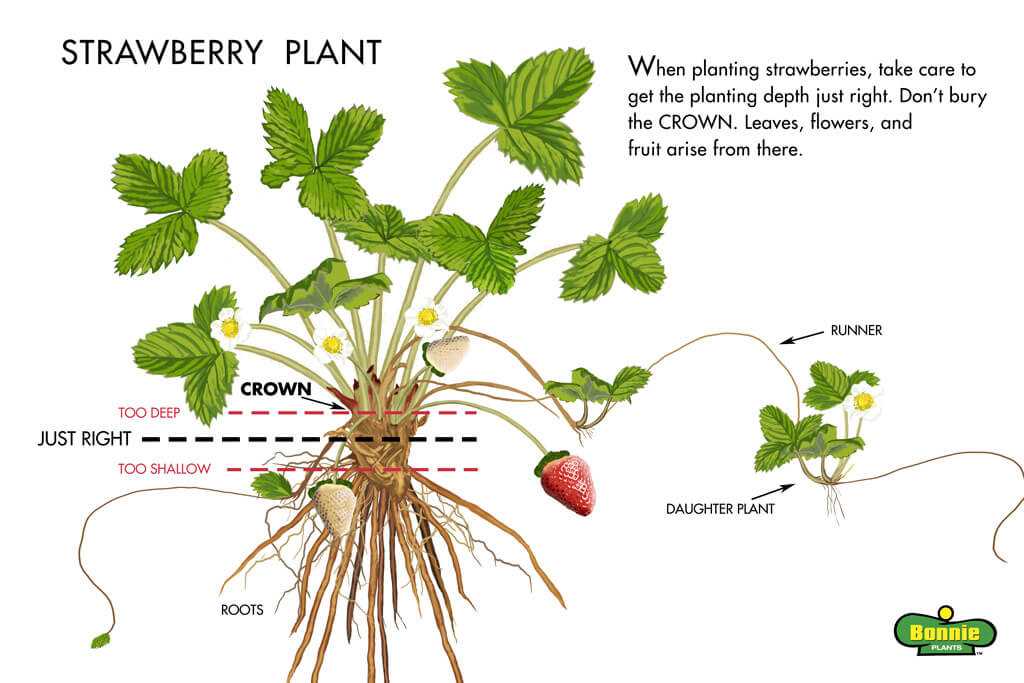

After applying fertilizer to your strawberry plants, make sure to water them thoroughly. This will help to dissolve the fertilizer and transport the nutrients down to the roots. Adequate moisture is essential for nutrient uptake and efficient utilization by the plants.
6. Monitor Soil pH
Strawberries prefer slightly acidic soil with a pH range of 5.5 to 6.5. Regularly test the soil pH and adjust it as necessary. If the soil is too alkaline, consider adding elemental sulfur to lower the pH. On the other hand, if the soil is too acidic, incorporate lime to raise the pH. Maintaining the correct soil pH will ensure that the strawberry plants can absorb the available nutrients effectively.
By following these fertilizing tips, you can provide your strawberry plants with the essential nutrients they need for optimal growth. With proper care and nourishment, you’ll be enjoying a bountiful harvest of delicious strawberries in no time.
Pruning and Maintaining Your Strawberry Plants
Proper pruning and maintenance are key to ensuring healthy and productive strawberry plants. By removing dead or diseased leaves, maintaining a tidy planting area, and selectively thinning out runners, you can help your strawberry plants thrive and produce a bountiful harvest.
1. Removing Dead or Diseased Leaves
Regularly checking your strawberry plants for dead or diseased leaves is essential for their overall health. Dead leaves can harbor pests and diseases, while diseased leaves can spread infection to other healthy plants. Use sanitized pruners to carefully remove any dead or diseased leaves from your strawberry plants, taking care not to damage the crown or stems.
2. Maintaining a Tidy Planting Area
Keeping the area around your strawberry plants clean and free of debris is important for maintaining plant health. Fallen leaves, weeds, and other organic matter can attract pests and provide a breeding ground for diseases. Regularly remove any debris from the planting area and use mulch to help suppress weed growth and retain moisture.
3. Selective Thinning of Runners
Strawberry plants produce runners, which are long stems that extend from the mother plant and develop new adventitious roots and plantlets. While these runners can be useful for propagating new plants, allowing too many runners to grow can result in overcrowding and reduce overall fruit production.
To maintain a healthy strawberry patch, selectively thin out runners by cutting them close to the mother plant. Choose the strongest and healthiest runners to allow to grow, while removing any excess ones. This will help to promote good air circulation and prevent overcrowding, ensuring that each plant has enough space to thrive and produce optimal fruit.
4. Regular Fertilization and Watering
Proper fertilization and watering are crucial for the ongoing health and productivity of your strawberry plants. Provide your plants with a balanced, slow-release fertilizer in early spring and continue to fertilize throughout the growing season according to the package instructions.
Water your strawberry plants regularly, keeping the soil consistently moist but not waterlogged. Avoid overhead watering, as wet leaves can encourage the development of fungal diseases. Instead, water at the base of the plants to ensure that the roots receive adequate moisture.
By following these pruning and maintenance techniques, you can help your strawberry plants stay healthy and productive, ensuring a bountiful harvest of delicious strawberries for years to come.
Question-answer:
What are some proper techniques for planting strawberries?
Some proper techniques for planting strawberries include preparing the soil by removing weeds and adding organic matter, creating raised beds or mounds for better drainage, spacing the plants properly, and providing adequate water and sunlight.
Why is it important to remove weeds before planting strawberries?
It is important to remove weeds before planting strawberries because weeds can compete with the strawberry plants for nutrients, water, and sunlight. By removing weeds, you give the strawberry plants a better chance to grow and thrive.
How should the soil be prepared for planting strawberries?
The soil should be prepared for planting strawberries by removing any existing weeds or grass, loosening the soil with a garden fork or tiller, and adding organic matter such as compost or well-rotted manure to improve the soil’s fertility and drainage.
Can strawberries be planted in raised beds or mounds?
Yes, strawberries can be planted in raised beds or mounds. This is done to improve drainage and prevent waterlogging, which can be harmful to the plants. Raised beds or mounds also make it easier to care for the plants and harvest the berries.
How far apart should strawberry plants be spaced?
Strawberry plants should be spaced about 12-18 inches apart. This allows enough room for the plants to grow and spread, while still providing adequate sunlight and air circulation for each plant.
What are the sunlight requirements for strawberry plants?
Strawberry plants require full sun, which means they need at least 6-8 hours of direct sunlight per day. Adequate sunlight is necessary for the plants to produce healthy foliage and develop sweet, juicy berries.
How often should strawberry plants be watered?
Strawberry plants should be watered regularly, especially during dry periods. It is recommended to water them deeply once or twice a week, providing about 1-1.5 inches of water per week. Proper watering helps the plants establish roots and produce plump, flavorful fruits.







